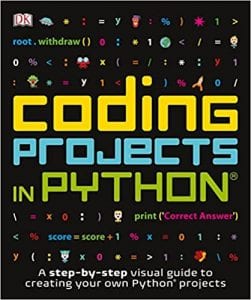The Best Coding Books and Tools for Kids

Our Review Process
Don't Waste Your Money is focused on helping you make the best purchasing decision. Our team of experts spends hundreds of hours analyzing, testing, and researching products so you don't have to. Learn more.
Our Picks For The Top Coding Tool For Kids
- 1. Sheena Vaidyanathan Creative Coding in Python
- 2. Osmo Interactive Hands-On Coding Game For Kids
- 3. Bob Mather Coding for Kids Ages 9-15
- 4. Workman Publishing Everything You Need to Ace Computer Science & Coding In One Big Fat Notebook
- 5. Playz STEM Science Coding Experiment Kit For Kids
- 6. Camille McCue Coding For Kids For Dummies, Second Edition
- 7. Learning Resources Screen-Free Android Coding Activity Kit For Kids
- 8. Adrienne Tacke Coding For Kids Python Activity Book
- 9. Reshma Saujani Girls Who Code: Learn To Code And Change The World
- 10. DK Coding Projects In Python
If your junior or senior high school students are ready to take coding to the next level, consider this book on coding for intermediate teens. It's filled with projects that inspire creativity, while also remaining fun to work on. Colorful illustrations and charts are used to make the material easier to comprehend, which is another reason this book...
Popular PickYou'll get a total of 30 projects when you opt for this book on coding for intermediate teens.
This coding for kids toy includes hands-on learning. Physical blocks help kids learn coding commands. The toy is perfect for kids ages 5 to 10.
Hands-On PickKids can learn coding commands using physical blocks.
The author of this book on coding for intermediate teens believes the younger you start learning coding the better. He structures the book as a step-by-step guide, which is easy for kids to follow. In addition to promoting creativity and organizational skills, this course also encourages teamwork.
Encourages TeamworkThis book on coding for intermediate teens is available in either a classic paperback or digital Kindle version.
This coding for kids book captures their interest with colorful illustrations. The book has 50 exercises to learn how to code with Python. The book is ideal for ages 10 and older.
Visually EngagingThis coding for kids book includes colorful illustrations.
Buying Guide
It may seem like coding is an adult skill, but kids as young as 2 or 3 can begin working on the building blocks of coding through fun toys and tools. If you want kids to explore STEM (science, technology, engineering and math) topics and learn the basics of coding, they are never too young to start.
There are many different books, tools and gadgets available that they can use to learn how to code in a fun way.
Learning how to code has many benefits for children. In a way, by learning how to code kids are learning a new language. Through this process, they can work on their written and verbal communication skills. Being exposed to a coding language while they are young helps children to understand how languages work and how people communicate. Coding also enables kids to better plan and organize their thoughts and the way they communicate.
Coding also enables children to improve their creativity and problem-solving skills. When they get stuck with an issue and don’t know how to move forward, coding forces them to think of different ways to solve the problem. Similarly, coding also encourages kids to work on their math skills and focus on the logical side of their brain.
While learning how to code, kids can gain a better understanding of how the technology around them operates. From their parents’ phones to the TV to the school computer, coding opens up a world of understanding for how technology can do what it is supposed to because of some behind-the-scenes work.
What to Look For
- When looking for coding toys and tools for kids, be sure to seriously consider the age group. There are coding-related toys for kids as young as those in pre-school to teenagers and beyond. Ensure the toy, book or gadget is age-appropriate so your child can understand it and use it on their own.
- In addition to making sure the kids coding activity you like is age appropriate, some may want to get one that grows with their kids. For example, if your child uses the toy when they are five, will they still be interested in the toy when they are seven or eight? Some toys grow with kids more effectively than others. Check to see if you can increase the difficulty on the toy to make it more challenging for kids as they grow.
- Some coding for kids toys and books require prior knowledge of coding or programming languages, while others are meant for beginners. Consider what level of understanding your child has and whether they need an activity for beginners or for someone who has an intermediate or advanced level of experience.
- Keep in mind your own coding knowledge and expertise. If you are a beginner yourself, you may want to learn coding along with your child and stay away from advanced coding tools until you have the knowledge to help your child if they require it.
- Some coding for kids tools focus on a specific programming language such as JavaScript or Python while others focus on basic coding skills and are language agnostic. Depending on the age, interest level and skill level of your child, you may want to select a specific programming language to learn as opposed to basic skills or vice versa.
More to Explore
If they haven’t experienced any coding activities before, kids may be hesitant or nervous to give it a try. If that’s the case, consider how you can make coding fun and interesting for your child.
For example, try adding a storytelling element with the coding activity or use tools that encourage storytelling. Kids are innately curious and imaginative, and may find it easier to learn a new skill when it is combined with something they already know and love.
You can also make coding more accessible by incorporating it into their daily routine. For example, after completing their homework every night, they can spend 15 minutes doing a fun coding activity, followed by something that relaxes their brain, like watching TV or playing outside.



















